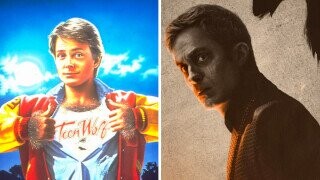Why Werewolf Comedy Works

With the build-up to Disney+’s release of Werewolf By Night this past few weeks, some folks and publications were scratching their heads and wondering why the streamer initially decided to label their adaptation of this Marvel horror comic a comedy — even though the trailer is considerably camp, and even though naming a werewolf Jack Russell is just inherently funny.
Still, the official labeling should probably be comedy horror, as it best reflects Disney’s TV film and adds to the hybrid genre’s many great films featuring wolf-human specimens. Comedy and horror have worked well together ever since that Frankenstein guy screeched, “It’s alive!” so many eons ago. The two genres are best cousins, and combining shock and horror with laughter and enjoyment have arguably made the horror genre more inclusive, catering to those who may not care for the pure dark and grotesque elements so often found in straight scary movies. Furthermore, mixing werewolf horror with comedy has always worked because, let’s face it, a human turning into a mutt is as hilarious as it is macabre.

Atlantic Releasing Corporation
Werewolf folklore has forever been open to comedic interpretation, much more so than their vampiric counterparts. The concept of turning into a runt has successfully been used to represent that dreaded transformation into puberty, with films like Teen Wolf, Dark Shadows, and Ginger Snaps poking fun at the hysteria of being a cursed freaking teenager.
Of course, when we think wolves, we think wolf packs, and many werewolf films have exploited this parallel by mocking how we humans engage on a social level. Joe Dante’s cult classic The Howling is an example of werewolf satire that examines the desire of people wanting to abandon mainstream societal norms, only to end up in an actual cult (of werewolves) who only want to soak in their own appetites. Josh Ruben’s 2021 comedy horror Werewolves Within inverted the concept, pitting a community of diverse individuals yelling “America!” against each other as they try to unmask the carnivorous lycanthrope among them, all the while ripping each other to shreds.
The obvious take on werewolf lore is the canine character’s innate and primal proclivity for violence, making it the perfect allegory for the nature of masculinity and its propensity for destruction. Jim Cummings’ 2020 satire horror The Wolf of Snow Hollow nails the examination of man’s violent capabilities going unchecked and running riot in a town where many folks — especially women — end up having to pay the price.
Of course, we can’t refrain from mentioning the “Werewolves, not swearwolves” in What We Do in the Shadows who so desperately try to control their own bad impulses, much to everyone's delight. Horror, at its best, is a catalyst that prompts us to observe and examine our own dark fears and inclinations. Comedy allows us to laugh at our absurdities and shortcomings. Combining the two makes sense, as the funny punchlines — if done right — provide us with an often needed cathartic experience. Comedy horror can be described as “comedy in chaos,” as the mirror keeps flipping to show us both sides of our nature. Werewolves are the perfect vehicles for this. The concept of man turning into beast allows us to examine our superstitions, reflect on our own bizarre and awkward bodies and hormones, and acknowledge our dark and troubled dispositions — all the while laughing at how incredibly silly we all are.
Also, werewolf transformations are downright hilarious, and not even the advent of CGI technology could make these movie scenes any less funny. Heck, even non-comedy werewolf horrors become unintentionally funny thanks to our apparent inability to make these conversions look authentic.
Comedy, as you fine folks know by now, is all about subverting expectations. We laugh at the unexpected and delight in newfound perspectives. Most all of the werewolf movies mentioned so far were modeled around some sort of subversive theme or element, and we can include An American Werewolf in London along with them — the movie that cleverly subverted the clichés of the genre itself back in the ‘80s. Possibly the best example here, however, is the werewolf coven in the Halloween-favorite film, Trick ‘r Treat, in which Anna Paquin dresses up as Little Red Riding Hood and gets stalked by some predator guy who looks like Pulp Fiction’ s The Gimp … only to turn into a werewolf and eat him alive.
Good stuff. More of this, and also more werewolf horror comedies, please.
Zanandi is forever howling on Twitter. Give her a follow.
Thumbnail: Atlantic Releasing Corporation, Disney+
